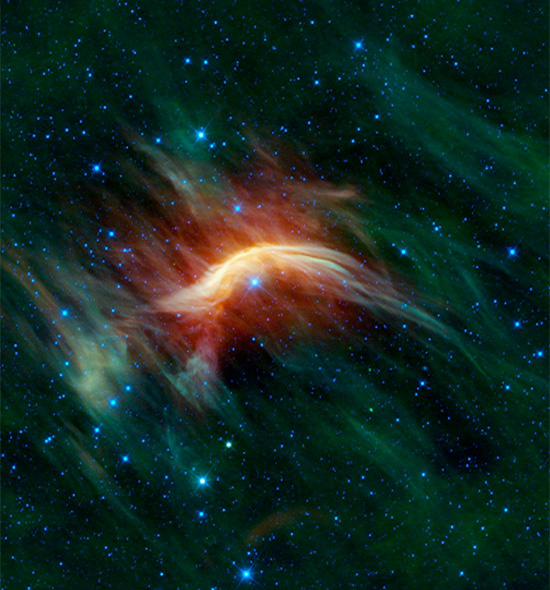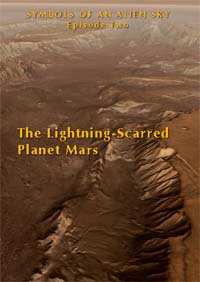|

Zeta Ophiuchi in infrared. Credit:
NASA/JPL-Caltech/UCLA
Shooting Star
Jan
31, 2011
What model best fits
heliospheric behavior?
"How now, wit! Whither wander
you?"
--- William Shakespeare:
As You Like it, Act 1, Scene
2
Space, it is said, is a vacuum.
Since the best pumped vacuum on
Earth reaches a 0.1 millimeter
spacing between individual atoms,
while, in comparison there is about
one atom per cubic centimeter
between stars, the label is not far
off the mark
The Interstellar Medium (ISM),
through which all stars move,
consists of gas and dust composed of
hydrogen and helium, with one-tenth
of a micron dust grains. One micron
equals one-millionth of a meter, so
the dust is smaller than the
wavelength of blue light (0.450
microns).
The ISM contains ionized
particles, as well as neutral
molecules. It is those electrons and
positive ions that are critical to
understanding the behavior of the
ISM and how stars interact with it.
Even though the ISM is extremely
diffuse, since charge separation
takes place in different regions
weak electric fields can develop.
Electric fields, no matter how weak,
initiate electric currents.
According to a recent
press release,
astronomers using the Wide-field
Infrared Survey Explorer (WISE) have
located a star whose "...powerful
winds push gas and dust out of its
way and into what is called a bow
shock."
It is assumed that the star's
velocity compresses gas and dust in
front of it as it flies through
space because its "stellar wind"
shoves gas and dust out of the way.
The so-called "bow shock" heats up
the ISM until it glows in the
infrared frequencies WISE can see.
However, instead of treating the
ISM like an inert medium, the
Electric Universe model sees it as a
magnetic, electrically charged
material that is affected by the
plasma sheaths around stars known as
magnetospheres. Stellar plasma and
the ISM are different plasmas, so
they develop Langmuir plasma
sheaths, or "double layers," between
them. Stars are where galactic
electric discharges are focused, so
the double layers form "virtual
cathodes."
Whenever electric discharges take
place in plasma, the current flow is
compressed inward by induced
magnetic fields. This effect is
known as a "z-pinch," and is a
foundational principle of
Electric Universe theory.
The compression can be so intense
that plasma is squeezed down into
solid particles. Indeed, stars and
galaxies are thought to owe their
existence to massive electric
currents forming cosmic z-pinches in
the vast clouds of plasma propelled
through the Universe by larger
electromagnetic fields.
When
Voyager 1 experienced
"events unlike any encountered
before in the mission's then 26-year
history" as it approached the
boundary between our own Sun and the
ISM, physicist
Wal Thornhill wrote that
the spacecraft was penetrating a
Langmuir plasma sheath that
insulates the solar plasma from that
in the ISM.
Since electric currents generate
magnetic fields, and magnetic fields
strong enough to hold tenuous clouds
of gas and dust together have been
found in the ISM, then electric
currents must be flowing through it
in order to create those fields.
Magnetic fields cause filamentation
of space plasma. The filamentary
nature of the "bow shock" around
Zeta Ophiuchi points to electric
currents and not kinetics as the
more likely explanation for its
appearance.
Stephen Smith
Hat tip to Jason Brown
Multimedia

The Lightning-Scarred Planet Mars
Symbols of an Alien Sky
DVD episode 2
A video documentary that could change everything you thought you knew
about ancient times and symbols.
The Symbols of an Alien Sky video series will introduce you to celestial
spectacles and earth-shaking events once remembered around the world.
Archaic symbols of these events still surround us, some as icons of the
world’s great religions, though the origins of the symbols appear to be
lost in
obscurity.
In this second episode of Symbols of an Alien Sky, David
Talbott takes the viewer on an odyssey across the surface of Mars.
Exploring feature after feature of the planet, he finds that only
electric arcs could produce the observed patterns. The high resolution
images reveal massive channels and gouges, great mounds, and crater
chains, none finding an explanation in traditional geology, but all
matching the scars from electric discharge experiments in the
laboratory.
(Approximately 85 minutes) See:
Lightning-Scarred
Planet info
|








